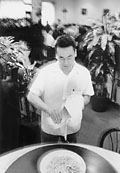Hua-Te Su stands over a boiling caldron, 20 pounds of green dough in his left hand. He skims a huge, U-shaped knife across the dough with even, rhythmical strokes. Long green noodles fly into the boiling water. Hand-shaven noodles are one of many things that make Su’s two Shanghai Garden restaurants both unique and splendid.
Shanghai Garden 524 Sixth, 625-1688 80 Front N, Issaquah, 425-313-3188 Sun-Thu 11-9:30, Fri-Sat 11-10:30 MC, V (no checks); beer, wine (full bar at Issaquah location)
Su and his wife, Helen, opened a small place in the International District in 1990 and moved to the more spacious location, with its lovely pale pink dining room, on Sixth Avenue two years later. The larger Issaquah restaurant opened in 1997. It’s a family affair for the Su children—Kathy, Betty, Christine, and Dan, now grown up and working in different capacities in the business.
Shanghai is in a region of eastern China blessed with a wonderful climate and fertile fields of rice, vegetables, and fruit. The surrounding lakes, rivers, and sea are rich with all manner of fresh and saltwater seafood. Shanghai chefs typically add a touch of sweetness to their dishes and are gentle with spices and seasonings. The emphasis is on the ingredients, which are plentiful and varied.
Su, 51, apprenticed from the age of 14 in Taipei under a well-known Shanghai chef. (Apprentices lived in the restaurant and had to learn the Shanghai dialect.) He emerged after five years as a master of a culinary art only recently appreciated in this country. A classicist, he’s steeped in the art and techniques of a millennia-old cuisine said to be the most highly developed in the world, with over 35,000 ingredients. He’s not stuck in classical strictures, though—he and his menus are in a constant state of evolution.
“When he hears of a new restaurant, he flies to San Francisco or New York just for dinner,” says his daughter Kathy, who manages both restaurants. Su goes to Taipei and Vancouver regularly, searching out new products, recipes, and trends.
“Healthy” is one of those trends. In the ’80s and ’90s, as cuisines like Thai and Vietnamese arrived and caught on, Chinese food fell out of favor, criticized for being overfried and loaded with MSG. While many joints still serve Kool-Aid-red sweet and sour, Su listened to his customers.
The universal attraction to filled things, from raviolis to kreplach, pirogis to pelmeni, wontons to empanadas, could be why the most popular Shanghai specialty in the US is what the Chinese call xiao long bao. Known variously as soup dumplings, soupy buns, or juicy dumplings, the flowery little packets of delicate dough twisted at the top usually contain some combination of minced meat (pork, shrimp, crab) and a spoonful of hot broth. Together the flavors explode in the mouth, although even when nibbled expertly it’s hard to eat a soup dumpling without leaving some on your shirt (see box).
Potstickers and dumplings differ only in that stickers are lightly fried on one side. Su’s stuffed efforts make those of lesser chefs pale. We tried the pan-fried meat dumplings ($4.95), Shanghai meat dumplings ($4.95), and the barley green potstickers ($5.95). The trick’s in the shot of soup—no small feat to keep captured in the dough and never found in the frozen, manufactured versions used by many local restaurants.
Shanghai cuisine is also famous for its cold appetizers—you must inquire about them because they’re listed in Chinese on the “specials” section of the menu. Try the spicy cucumbers or the sensational braised bamboo. The drunken chicken is marinated in shao xing, a sweet wine; vegetarian goose has black Chinese mushrooms and slivers of bamboo shoots in a tofu skin wrapper, browned and chilled. Warning: The prices for the specials are also in Chinese, so it’s hard to say what cost what—not that this will matter to you when you savor these delicacies.
The vegetable menu is extensive. Make sure you don’t miss the black mushroom with sugar pea vines ($11.95)—Su’s staff spends many hours picking through cases of the expensive vines to serve only the most tender leaves. The bamboo fungus with green cabbage ($8.95) is a wonderful stir of tiny bok choys with the white fungus soaking up the juices and providing a spongy, meaty texture. You can make tacos of the little pancakes with the mu shu vegetable ($6.95) or enjoy it as a vegetable side dish. The eggplant with Szechuan sauce (with or without pork) is spicy and full-flavored, as are the dry sauteed string beans ($7.95) and the hot braised bean curd ($7.95).
Su’s hand-shaven noodles are sometimes made with fresh corn or carrots. Barley greens are pressed like wheat grass and the juice is added to the dough, making noodles that look like Italian spinach pasta but are more nutritious and have a fresher taste. Try the barley-green hand-shaven chow mein ($8.95), which is full of meat, seafood, and vegetables, or the shrimp with barley-green noodle soup ($8.95).
Chinese don’t traditionally eat brown rice, and Su says many of his older Chinese customers turn up their noses at his “high nutrition brown rice” dishes. Using five different kinds of brown rice, he stirs in egg, chicken, beef, and shrimp in the House Special ($7.50). Don’t get me wrong; this is not a health-food place tailored to Western tastes. This is a serious Chinese restaurant with a large Chinese clientele. And Chef Su’s innovations and the warmth of his family have put both Shanghai Garden restaurants into the upper stratum of our ever more formidable restaurant scene.
The Shanghai emphasis on seafood, coupled with our coastal bounty, makes for some unforgettable dishes. We loved the pepper salted scallops ($14.95) and the pepper salted shrimp ($12.95), dusted in sweet potato powder and fried, giving them a thin, crunchy, M&M-like shell that when chomped gives a mouthburst of the sea with the sedate heat of white pepper. Try a braised whole fish with sweet chili sauce (seasonally available and priced). Other don’t-miss-’ems are the sliced fish with yellow leek ($14.95) and the sauteed crab with brown sauce (priced seasonally).
Su’s light hand also extends to meat dishes. We loved the chicken with strawberries ($10.95), chicken breast meat in a sweet and tangy strawberry sauce. Beef with orange flavor ($9.50) combines tender strips of flank with a true-fruit sauce. Garlic and ginger chicken ($8.50) amazed us with its nontraditional ingredients—fresh basil leaves, whole garlic cloves, and fresh jalapenos.
Did I mention the ice cream? Su makes his own—the flavor du jour when we visited was made from dried longan (or Dragon’s Eye) fruit, a close relative of the lychee. The coffee-colored ice cream was creamy and tasted like, well, longan, a wonderfully spicy-rich taste unlike any flavor I’ve ever had. Regulars expect unusual flavors and have gotten honeydew, passion fruit, and sour plum. The Shanghai deep-fried ice cream ($3.50)—homemade vanilla fried in a wonton wrapper—is another crowning glory to a glorious meal indeed.








